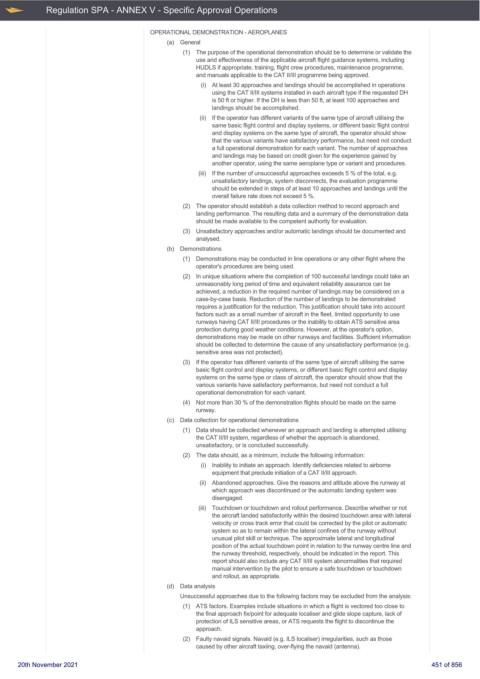Page 451 - UK Air Operations Regulations (Consolidated) 201121
P. 451
~
~ Regulation SPA - ANNEX V - Specific Approval Operations Centrik
OPERATIONAL DEMONSTRATION - AEROPLANES
(a) General
(1) The purpose of the operational demonstration should be to determine or validate the
use and effectiveness of the applicable aircraft flight guidance systems, including
HUDLS if appropriate, training, flight crew procedures, maintenance programme,
and manuals applicable to the CAT II/III programme being approved.
(i) At least 30 approaches and landings should be accomplished in operations
using the CAT II/III systems installed in each aircraft type if the requested DH
is 50 ft or higher. If the DH is less than 50 ft, at least 100 approaches and
landings should be accomplished.
(ii) If the operator has different variants of the same type of aircraft utilising the
same basic flight control and display systems, or different basic flight control
and display systems on the same type of aircraft, the operator should show
that the various variants have satisfactory performance, but need not conduct
a full operational demonstration for each variant. The number of approaches
and landings may be based on credit given for the experience gained by
another operator, using the same aeroplane type or variant and procedures.
(iii) If the number of unsuccessful approaches exceeds 5 % of the total, e.g.
unsatisfactory landings, system disconnects, the evaluation programme
should be extended in steps of at least 10 approaches and landings until the
overall failure rate does not exceed 5 %.
(2) The operator should establish a data collection method to record approach and
landing performance. The resulting data and a summary of the demonstration data
should be made available to the competent authority for evaluation.
(3) Unsatisfactory approaches and/or automatic landings should be documented and
analysed.
(b) Demonstrations
(1) Demonstrations may be conducted in line operations or any other flight where the
operator's procedures are being used.
(2) In unique situations where the completion of 100 successful landings could take an
unreasonably long period of time and equivalent reliability assurance can be
achieved, a reduction in the required number of landings may be considered on a
case-by-case basis. Reduction of the number of landings to be demonstrated
requires a justification for the reduction. This justification should take into account
factors such as a small number of aircraft in the fleet, limited opportunity to use
runways having CAT II/III procedures or the inability to obtain ATS sensitive area
protection during good weather conditions. However, at the operator's option,
demonstrations may be made on other runways and facilities. Sufficient information
should be collected to determine the cause of any unsatisfactory performance (e.g.
sensitive area was not protected).
(3) If the operator has different variants of the same type of aircraft utilising the same
basic flight control and display systems, or different basic flight control and display
systems on the same type or class of aircraft, the operator should show that the
various variants have satisfactory performance, but need not conduct a full
operational demonstration for each variant.
(4) Not more than 30 % of the demonstration flights should be made on the same
runway.
(c) Data collection for operational demonstrations
(1) Data should be collected whenever an approach and landing is attempted utilising
the CAT II/III system, regardless of whether the approach is abandoned,
unsatisfactory, or is concluded successfully.
(2) The data should, as a minimum, include the following information:
(i) Inability to initiate an approach. Identify deficiencies related to airborne
equipment that preclude initiation of a CAT II/III approach.
(ii) Abandoned approaches. Give the reasons and altitude above the runway at
which approach was discontinued or the automatic landing system was
disengaged.
(iii) Touchdown or touchdown and rollout performance. Describe whether or not
the aircraft landed satisfactorily within the desired touchdown area with lateral
velocity or cross track error that could be corrected by the pilot or automatic
system so as to remain within the lateral confines of the runway without
unusual pilot skill or technique. The approximate lateral and longitudinal
position of the actual touchdown point in relation to the runway centre line and
the runway threshold, respectively, should be indicated in the report. This
report should also include any CAT II/III system abnormalities that required
manual intervention by the pilot to ensure a safe touchdown or touchdown
and rollout, as appropriate.
(d) Data analysis
Unsuccessful approaches due to the following factors may be excluded from the analysis:
(1) ATS factors. Examples include situations in which a flight is vectored too close to
the final approach fix/point for adequate localiser and glide slope capture, lack of
protection of ILS sensitive areas, or ATS requests the flight to discontinue the
approach.
(2) Faulty navaid signals. Navaid (e.g. ILS localiser) irregularities, such as those
caused by other aircraft taxiing, over-flying the navaid (antenna).
20th November 2021 451 of 856

